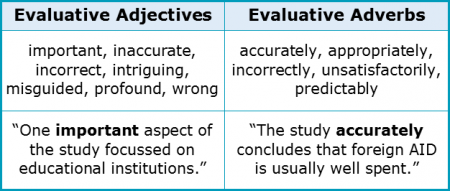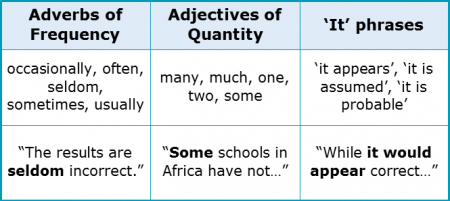Which language best shows stance in an essay?

This is the second of three chapters about Stance. To complete this reader, read each chapter carefully and then unlock and complete our materials to check your understanding.
– Discuss how stance may be positive or negative
– Demonstrate how the strength of stance may be altered
– Provide examples of five useful language types for showing stance
Chapter 2
Now that we’ve discussed what stance is in academic writing and when it should be included by an author, this second chapter focusses on the variety of language types and structures that may be utilised by a writer to indicate their evaluations, judgements or opinions. Strongly connected with the concepts of voice, concession and rebuttal, hedging language, reporting verbs and more general evaluative language, the words and phrases which are commonly used to indicate stance in English vary considerably in the context of academic essays. Such variation is of course due to the variability of opinions that may relate to any possible topic.
Such variability can be demonstrated by first returning to our example thesis statement from Chapter 1 about foreign AID in Africa:


In this example diagram, the red cross indicates that the writer agrees to some degree with the overall concept that foreign AID is effective. However, this opinion could be more strongly expressed in the thesis statement with the simple addition of an evaluative word such as ‘clearly’ (“the effectiveness of foreign AID in Africa is clearly apparent”), changing the stance from ‘agree’ to ‘strongly agree’.
Stance then, is quite malleable. To demonstrate an opposing opinion on the same topic, we’ve rewritten our original thesis statement below and provided a diagram that indicates the overall strength of the writer’s stance. Bolded evaluative language such as ‘strongly argues’ works to demonstrate the strength of the opinion, while a concession beginning with ‘although’ allows the writer to weigh up both sides of the argument (as is usually necessary when writing persuasively):


Having now discussed how stance may be altered to demonstrate the strength of an opinion, evaluation or judgement, the following five language groupings have been provided to assist learners with the inclusion of stance in academic assignments.
1. Evaluative Vocabulary
Evaluative language is one of the most important ways of demonstrating stance, with adjectives and adverbs being the most useful evaluative word classes. The below table offers some of the most frequently occurring evaluative academic vocabulary for students to use in their essay writing.

2. Modal Vocabulary
Another important language type that shows stance most effectively is the modal language of any of the four lexical word forms (adjectives, adverbs, nouns and verbs). Modal language such as the example vocabulary in the table below is particularly useful for evaluating body-paragraph evidence and arguments:

3. Reporting Language
Reporting verbs and phrases are also useful when expressing stance, particularly when including sources as cited evidence within the body section of an essay. Verbs such as ‘report’, ‘question’ or ‘argue’ allow the writer to provide their own interpretation of the stance or argumentative strength of the source authors who conducted the original research. The following table therefore provides examples of some of the most useful reporting verbs split into their weak, neutral or strong evaluative categorisations. Our short three-chapter reader on the topic of reporting verbs will naturally provide you with a more comprehensive list than is provided below – as well as instruction on each verb’s associated grammar and syntax.

4. Hedging Language
Although some of the evaluative and modal vocabulary described previously may be considered a form of hedging language, there are still additional groups of words under this categorisation that may prove useful to an academic writer. The language of hedging offers an important way to demonstrate stance throughout an essay as such language not only shows degrees of certainty but also works to protect the writer from errors or inconsistencies in their opinions or judgements. Although our short reader on hedging language provides a more comprehensive list, some of the most important stance-based language has been outlined in the table below:

5. Signalling and Attitude Markers
The final two types of language that are useful for expressing stance are signalling and attitude markers. Signalling words such as ‘although’ and ‘similarly’ may be used to provide concession about an argument or connect two concepts together, for example. Attitude markers however, such as ‘interestingly’, can provide quick and concise overall judgements about concepts or pieces of evidence. The following table therefore provides a quick-reference list of the most common and academically appropriate signalling language and attitude markers for use in academic writing.

Now that you should have a good understanding of the types of language available to a writer in order to present stance, the final chapter on this topic more closely considers how a writer’s stance can be maintained throughout an entire essay.
To reference this reader:
Academic Marker (2022) Stance. Available at: https://academicmarker.com/essay-writing/introductory-paragraphs/stance/ (Accessed: Date Month Year).
Downloadables
Once you’ve completed all three chapters about stance, you might also wish to download our beginner, intermediate and advanced worksheets to test your progress or print for your students. These professional PDF worksheets can be easily accessed for only a few Academic Marks.
Collect Academic Marks
-
100 Marks for joining
-
25 Marks for daily e-learning
-
100-200 for feedback/testimonials
-
100-500 for referring your colleages/friends